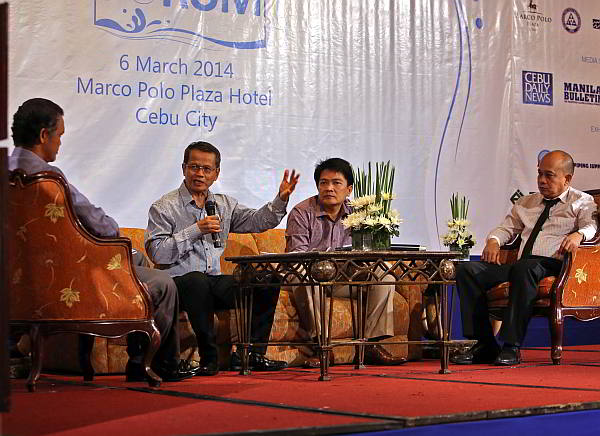MCWD targets to shift to surface water sources
(FIRST OF 2 PARTS)

WATER IS LIFE. Dr. Isabelo Montejo (2nd from left) regional executive director of the Department of Environment and Natural Resources 7 answers questions from participants of the Water Challenge Forum at Marco Polo Plaza Hotel yesterday. With him are Ulysses Rabor (3rd from left), Water Utility Manager Grundfos Pumps Phils., Engr. Lasaro Salvacion (right) Manager of the Environment and Water Resource Department the Metropolitan Cebu Water District and Engr. Andres Muego (left) Environmental Advisor / General Manager of the Office of the Provincial Board of the 6th District of Cebu.
(CDN PHOTO/LITO TECSON)
A SLIGHT girl in her teens empties two pails of water she fetched from a large steel container outside their house to a smaller container in their kitchen.
Each wobbly step to her home causes the water in the pails carried by Janina to slosh over the rims and soak the young girl’s clothes.
And she had to do this every time she is tasked to wash the dishes or do the laundry.
Her family who lives in upland barangay Busay in Cebu City relies on an entrepreneur who brings a tank-load of water from the city proper and sells it in their neighborhood at P55 per cubic meter.
This is higher than the commercial rate charged by the Metro Cebu Water District (MCWD) of P40 per cubic meter.
Since their consumption is limited to household needs, they could have paid less but they were left with no choice because they didn’t have a water connection.
MCWD’s service area covers Talisay City, Cebu City, Mandaue City, Consolacion, Lilo-an, Compostela, Lapu-Lapu City and Cordova town.
But MCWD Board of Directors Chairman Rene Mercado reveals they were only able to serve 42 percent of the total demand in their service area.
The remaining 58 percent do not have water connection and had to find ways to source their water.
Some households, like that of Janina’s had to pay higher rates to enterprising individuals reselling water. Most subdivisions, commercial establishments or industrial areas drill their own deep wells.
“Although our pipelines have not reached 58 percent of our franchise area, everybody still has water because if you own a subdivision you have an initiative to pump water and develop your own water system,” Mercado said.
MCWD has 140 wells and 30 observation wells in their franchise area while private wells number in the thousands.
MCWD has appraised 16,000 domestic and private wells for Lapu-Lapu City alone and 900 “big” (industrial/ commercial) wells in Mandaue City says Lemuel Canastra, manager of MCWD’s Surface Water Division of the Environment and Water Resource Department.
They have not yet counted the domestic wells in Mandaue City and in the populous cities of Cebu and Talisay and Consolacion town.
The National Water Resources Board (NWRB) has estimated a daily extraction of 500,000 cubic meters for both private and MCWD in Metro Cebu according to a study conducted by Japan International Cooperation Agency (JICA)
The 180,000 cubic meters are extracted by MCWD, the rest are by private individuals.
Unlike MCWD, most if not all of these private wells do not have a meter that monitors the amount of groundwater they are extracting which makes groundwater extraction difficult to manage.
What is worse, according to MCWD, is that private wells are installed close to the shoreline.
“A small extraction near the coast has a bigger effect than the bigger amount of extraction of MCWD wells inland,” says Lasaro Salvacion, Department Manager of the Environment and Water Resources Department (EWRD) of MCWD.
Groundwater extraction near the coast will induce a rapid flow of seawater to the freshwater aquifer thereby decreasing the amount of fresh water which naturally flows out to the sea and subsequently affects the water’s taste and quality.
But these private wells would not have been developed if MCWD was able to fulfill its mandate to provide potable water for all in their franchise area because of their insufficient distribution network.
“Without the proper methods and monitoring, the threat to our aquifer will continue,” Salvacion added referring to salt water intrusion as the imminent threat.
Disclaimer: The comments uploaded on this site do not necessarily represent or reflect the views of management and owner of Cebudailynews. We reserve the right to exclude comments that we deem to be inconsistent with our editorial standards.
